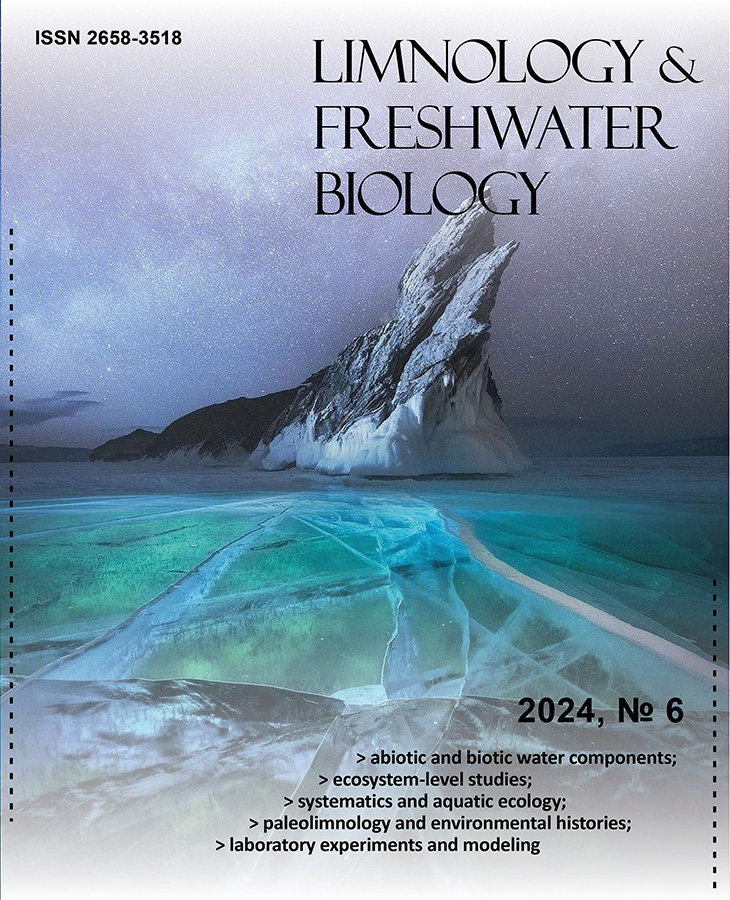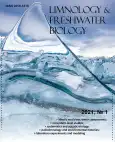No 1 (2021)
Articles
Dolichospermum lemmermannii (Nostocales) bloom in world’s deepest Lake Baikal (East Siberia): abundance, toxicity and factors influencing growth
Abstract
Mass development of the cyanobacteria Dolichospermum (D. lemmermannii as the dominant species) was reported in the coastal zone of Bol’shye Koty Bay (western coast of the southern basin), towards the end of July to the beginning of August in 2019. Blooms were observed as 1–1.5-m wide bands adjoining the shoreline and stretched uninterrupted over 2 km. Abundance of cyanobacteria in blooms varied within 7.2–71.9 thousand cell mL-1, with 0.73–7.20 g m-3 biomass attained. Maximal concentration was observed opposite the biological station of Irkutsk State University, a frequently visited place that was hosting participants of several conferences at that time. Hydrochemical analysis of samples collected four days after continuous heavy rains showed much higher concentrations of nutrients in contrast with the data obtained a week before (24 July), which is normal for that season. Nutrient concentrations were elevated relative to long term averages by 3 to 30 fold: with phosphate concentrations up to 0.200 mg L-1, ammonium ions 0.29 mg L-1, and nitrates 0.31 mg L-1. Possible reasons for the harmful freshwater cyanobacterial bloom that is unusual for this part of the lake are discussed. Excessive proliferation of common cyanobacteria D. lemmermannii in the open lake areas was affected by several factors: long-lasting heavy rains, zero wind, high air (from 13–15°С at night to 29°С in daytime) and water temperatures (from 15°С to 19.2°С); and absence of isolated septic tanks in the nearshore zone.
 1101-1110
1101-1110


Actual inflow of riverine sediment load into Lake Baikal: main tributaries – the Selenga, Upper Angara, and Barguzin Rivers (Russia)
Abstract
The sediment load delivery into Lake Baikal from its main tributaries – the Selenga, Upper Angara, and Barguzin Rivers has been reduced since the mid-1970s. This is explained by climate change and socioeconomic activities. Integrated analysis of changes in hydro-meteorological parameters (water discharge, sediment load, air temperature, precipitation) and their trends over the period 1946–1975 (baseline) and 1976–2017 (warming) is performed. Changes in natural processes and human activity were negligible during the baseline period. During the warming period, the greatest reduction of the sediment load inflow against the background of temperature rise and precipitation decrease occurred in the interval between 1996 and 2017 in the Selenga River, between 1985 and 2017 in the Upper Angara River, and between 1992 and 2017 in the Barguzin River. The flux of the sediment load into these rivers was 768×103, 88×103, and 29×103 t y −1, respectively. This is 2–3 times less than the average multiyear values for all period of 1946–2017, which are usually used when characterizing sediment load runoff from these rivers. Currently the values in the given intervals correspond to the actual sediment load flux into Lake Baikal from the main tributaries.
 1111-1114
1111-1114


The geochronology of a palaeolake at the Pleistocene/Holocene transition in the Muya-Kuanda Basin (Eastern Siberia, Russia)
Abstract
This article presents new data on the study of preserved wood from flooded forests in the Muya-Kuanda Basin, Eastern Siberia. On the basis of the stratigraphic position of a buried tree stump horizon, the analysis of the associated alluvial deposits and a new programme of radiocarbon dating, the chronology of formation and collapse for a Late Pleistocene palаeolake in the Muya-Kuanda Basin can be precisely determined. The accuracy of dating of geological events with the radiocarbon method and the possibility of linking them to calendrical dates is discussed. As a result of this research it is possible to connect the geochronology of the lake with archaeological sites in the Vitim Basin, both upstream and downstream along the river. The reasons for the periodic formation of substantial bodies of water in the Muya-Kuanda Basin are also discussed, with implications for decision making with regard to the modern economic development of the region.
 1115-1125
1115-1125











